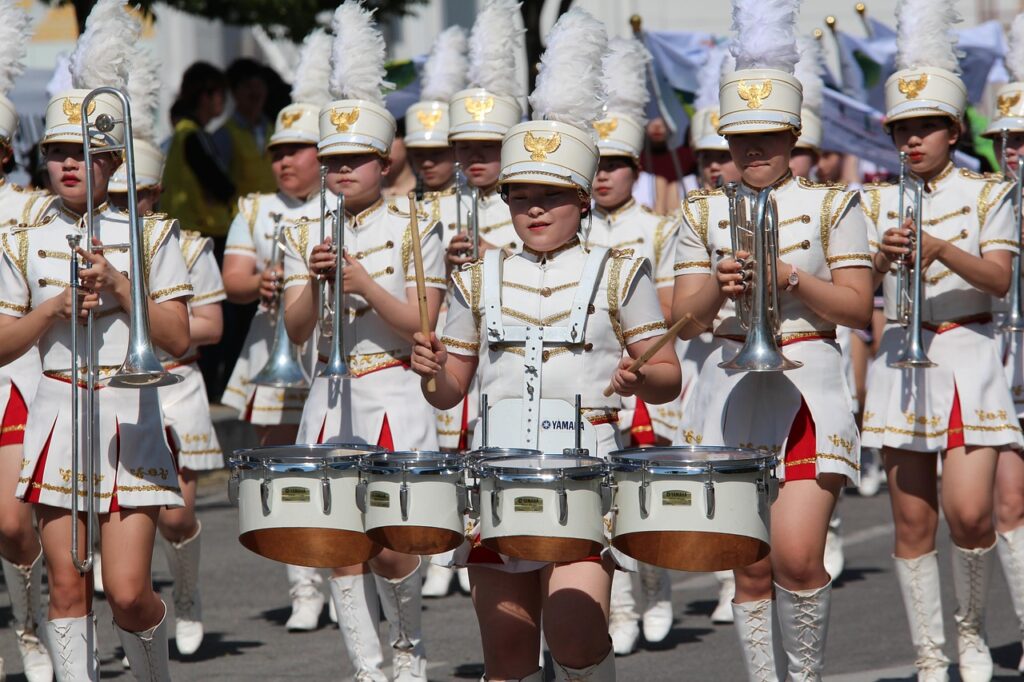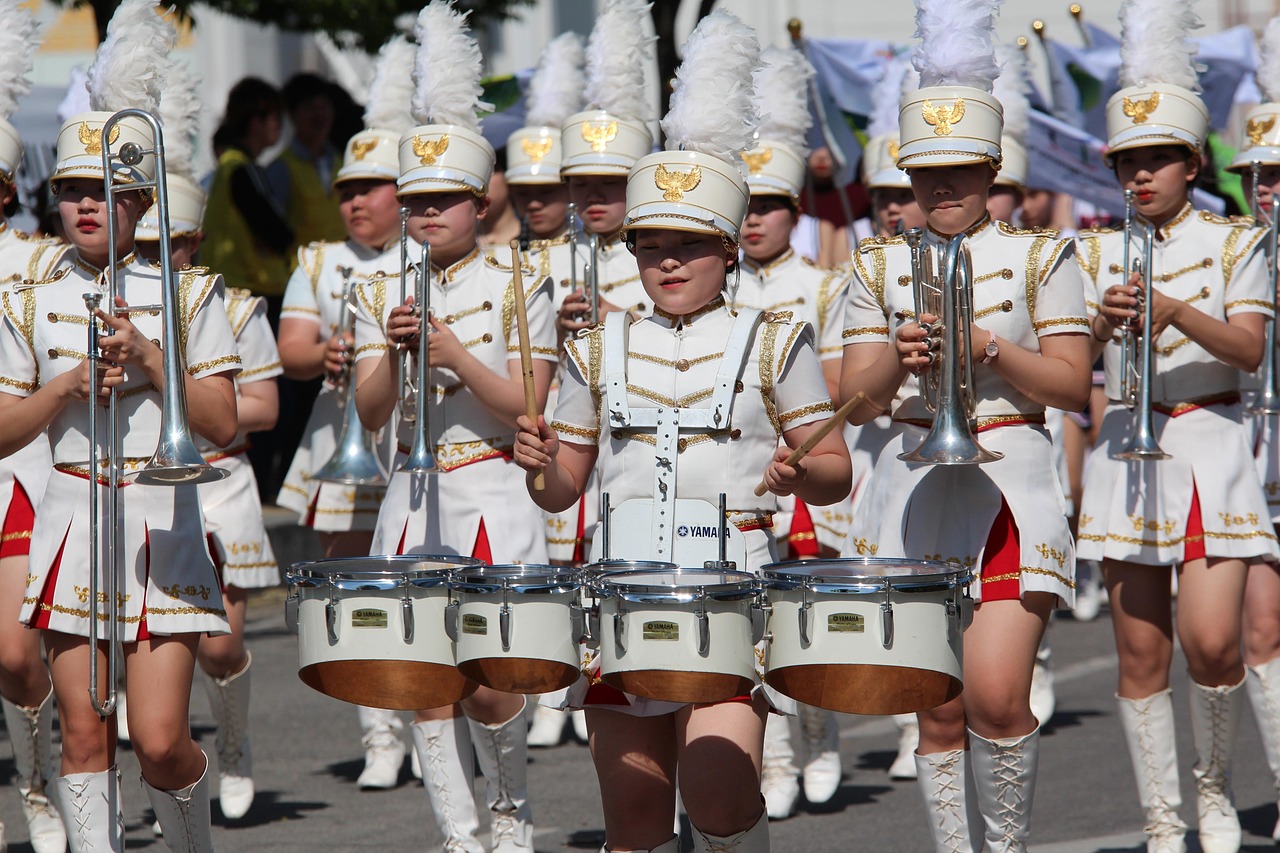Marching band is a popular activity in schools and communities, often seen at football games or in competitions. But is marching band a sport? This question has sparked debate, with some viewing it as an athletic endeavor and others as a performance art. Let’s break it down simply to understand both sides.
Marching band involves carrying heavy instruments, long practice hours, and competitions with judges, much like sports teams. For example, ESPN compared a drum player’s heart rate to a marathon runner’s, showing its physical intensity. Some schools even offer it as an athletic credit, recognizing its demands.
On the other hand, marching band lacks elements like balls or direct opponent competition, often classified under arts rather than athletics. It’s more about prepared performances, similar to dance, and some argue its physical effort doesn’t match traditional sports like football.
There’s no simple answer, but marching band clearly requires dedication and effort. It might be best seen as a blend of sport and art, deserving respect regardless of classification.
Comprehensive Analysis: Is Marching Band a Sport?

Before exploring whether marching band is a sport, it’s essential to establish what constitutes a sport. According to the Oxford English Dictionary, a sport is “an activity involving physical exertion and skill in which an individual or team competes against another or others for entertainment.”
This definition is broad and can encompass activities ranging from traditional team sports like football to less conventional ones like chess (a mind sport) or eSports.
However, traditional sports often involve elements such as direct competition, physical contact, or the use of equipment like balls or pucks. Marching band, while sharing some of these characteristics, also diverges in significant ways, which fuels the ongoing debate.
Arguments For Marching Band as a Sport
Proponents of classifying marching band as a sport highlight several key factors that align with traditional definitions of athletic activities. These arguments are supported by various sources, including student opinions, professional analyses, and institutional practices.
Physical Demands
Marching band is physically demanding, requiring members to carry heavy instruments—such as tubas, drums, or cymbals—while marching in precise formations for extended periods. Practices can last several hours daily, sometimes under challenging weather conditions, such as heat or rain.
For instance, a source from marchingband.com notes that ESPN once compared the heart rate of a Cavalier tenor drum player during a performance to that of a marathon runner, illustrating the cardiovascular intensity of the activity.
Band members also engage in physical warm-ups, such as running laps or stretching, before rehearsals, further emphasizing the athletic nature of their preparation.
Comments from band members, such as those in The Epitaph, highlight the breathlessness caused by playing at 180 beats per minute or carrying 80-pound tenor drums, reinforcing the physical toll.
Skill and Coordination
Playing an instrument while marching requires exceptional skill and coordination. Musicians must read music, maintain rhythm, and execute precise movements simultaneously. This multitasking demands focus, discipline, and teamwork—qualities that are also essential in traditional sports.
The ability to synchronize with other band members while performing complex routines is akin to the coordination required in team sports like basketball or soccer. For example, a comment from The Epitaph notes the active thinking and stress during shows, similar to sports training, underscoring the mental and physical demands.
Competitive Nature
Marching bands frequently participate in competitions, such as field shows or parades, where they are judged on musicality, visual performance, and overall effect. These events often involve travel to different locations, much like sports teams competing in tournaments.
Organizations like Bands of America (BOA) and Drum Corps International (DCI) host large-scale competitions with clear winners and losers, attracting thousands of spectators. The competitive structure, complete with judges and scoring systems, mirrors that of traditional sports.
For instance, FHC Sports Report details how competitions can last hours, with bands from nearby schools gathering to compete, involving judges, point systems, and clear outcomes.
Teamwork
Like sports teams, marching bands rely on collaboration. Each member plays a crucial role in the overall performance, with sections (e.g., woodwinds, brass, percussion) working together to create a cohesive show.
Band members must communicate effectively, support one another, and adapt to challenges during performances—qualities that are fundamental to team sports. A comment from The Epitaph emphasizes the collective help within the band, countering claims of individuality and highlighting the team dynamic.
Recognition in Some Contexts
In certain schools and districts, marching band is treated as a sport. For example, in Texas, some school districts offer marching band as a full-year athletic credit, as noted in a Reddit discussion (r/marchingband).
This recognition underscores the physical and competitive aspects of the activity, further supporting its classification as a sport. Additionally, some schools require doctor’s physicals for participation and have demanding 3-hour summer practices, aligning with athletic requirements (marchingband.com).
Arguments Against Marching Band as a Sport
Despite these arguments, many contend that marching band does not meet the traditional criteria for being a sport. Critics, including columnists and educators, raise several points to support this view, drawing from various sources and comparisons.
Lack of Traditional Sport Elements
Marching band lacks many elements commonly associated with sports, such as a ball, goal, or direct opposition between teams. Instead, it is a performance judged by panels of experts rather than a real-time competition.
Unlike football or basketball, where teams directly compete against each other, marching band competitions involve bands performing separately, with judges determining rankings based on predetermined criteria. The Daily Eastern News argues that a sport requires an object of play, like a ball or puck, and marching band’s focus on musical and physical expression for entertainment does not fit this mold.
Performance Art
Critics argue that marching band is more akin to a performance art than a sport. It combines music, dance, and theater, with the primary goal of entertaining an audience rather than achieving athletic victory.
The emphasis on artistic expression, creativity, and storytelling sets it apart from traditional sports, which prioritize physical prowess and strategic gameplay. For example, marchingband.com notes that marching band fits more closely with definitions of performance art, such as those from Oxford and Dictionary.com, rather than sport.
School Classification
In most schools, marching band falls under the music or fine arts department, not the athletic department. This classification reflects its artistic nature and suggests that it is not viewed as a sport by educational institutions.
Athletic departments typically oversee sports teams with coaches, seasons, and leagues, whereas marching bands are led by music directors and are part of the arts program. marchingband.com highlights that in schools, it is classified under music/arts, not athletics, reinforcing this view.
Physical Exertion Compared to Sports
While marching band requires physical effort, some argue that it does not match the intensity of traditional sports. For example, football players engage in high-intensity, contact-based activities, whereas marching band members primarily walk and play instruments.
The physical demands, while significant, are different in nature and less comparable to those of contact sports or endurance-based athletics. The Daily Eastern News compares it to walking for pleasure, suggesting it does not meet the athletic threshold of sports like basketball, which require constant running.
Prepared Performances vs. Real-Time Competition
Marching band competitions involve prepared routines rather than real-time, unpredictable gameplay. Bands rehearse their shows extensively before performing, leaving little room for on-the-fly decision-making or adaptation during the competition.
This contrasts with sports like basketball or soccer, where teams must react to opponents’ strategies in real time. The Epitaph notes that competitions are prepared performances, not real-time team-on-team interactions, with less on-the-fly decisions compared to sports.
Scoring Interpretation
The interpretive nature of scoring in marching band competitions, with different emphases and judge preferences, is another point of contention. The Daily Eastern News argues that this disqualifies it from being a true sport, as sports typically have more objective scoring systems, such as points scored in basketball or goals in soccer.
Comparative Analysis: Marching Band vs. Other Activities
To further clarify, let’s compare marching band to other activities. For instance, diving, figure skating, and gymnastics are Olympic sports considered performance-based, with prepared routines judged by panels, similar to marching band. marchingband.com notes that these activities have a competitive history length similar to marching band, yet are classified as sports.
Similarly, synchronized swimming is debated, with some viewing it as a sport and others as a performance, mirroring the marching band debate. However, activities like ballet and dancing, while competitive and athletic, are not typically classified as sports, aligning with arguments against marching band’s sport status.
The Community and Dedication of Marching Band
Beyond the debate over its classification, marching band fosters a unique sense of community and dedication. Many students spend years in marching band, forming close bonds with peers and directors.
As one band member shared in The Epitaph, “My whole life revolves around marching band because most of my friends are also in it.” This sense of belonging is similar to that found in sports teams, where members support and rely on each other.
Moreover, the hard work and commitment required in marching band are often underappreciated. Band members endure long hours of practice, sometimes in extreme weather conditions, and face the pressure of performing flawlessly in competitions.
“Hell week,” a period of intense rehearsals before major events, is a testament to their dedication, as noted in marchingband.com. Comments from band members, such as those in The Epitaph, highlight the stress and active thinking during shows, comparing it to sports training and emphasizing the mental and physical challenges.
Benefits of Recognizing Marching Band as a Sport
If marching band were officially recognized as a sport, it could lead to several benefits. For one, it might receive more funding from schools, as athletic departments often have larger budgets than music departments. This could translate to better equipment, uniforms, and facilities for band members.
Additionally, recognition as a sport could increase the prestige and visibility of marching band programs, attracting more students and potentially leading to scholarships for talented musicians, as suggested in FHC Sports Report. However, some argue that marching-band should remain under the arts department to preserve its creative and expressive nature, potentially avoiding the pressures and expectations associated with sports.
Conclusion
The debate over whether marching band is a sport is complex and multifaceted. On one side, proponents highlight its physical demands, skill requirements, competitive nature, and teamwork, arguing that it fits the definition of a sport.
On the other side, opponents emphasize its lack of traditional sport elements, its classification as a performance art, and its distinction from athletic activities in terms of intensity and structure.
Ultimately, whether marching band is classified as a sport may depend on one’s perspective and definition of what constitutes a sport. If we adhere strictly to traditional definitions, marching band may not qualify.
However, if we consider the broader aspects of physical exertion, skill, and competition, it certainly has a strong case. Perhaps it is best to view marching band as a unique activity that blends elements of both sport and performance art, deserving recognition for the dedication and hard work of its participants.
Whether or not it is officially deemed a sport, marching band plays a vital role in fostering community, creativity, and discipline among its participants, as evidenced by the detailed arguments and community insights from various sources.
